|

Arthur Wellesley
Anglo-Portuguese Expeditionary Force
36,960 British infantry
4,160 cavalry
40 artillery |

Count Castanos
Left Wing of Army Real
43,200 Spanish infantry
4,800 cavalry
32 artillery pieces |
THE SECOND BATTLE OF SEGOVIA
July 24th - 1809
Great War of Defiance Memoirs |
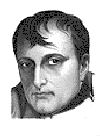
Emperor Napoleon
Armee de Pyrenees
36,960 French infantry
7,680 cavalry
64 artillery |
Following the First Battle of Segovia on
19 April, Kellerman's III Corps felt itself in no position to pursue the
battered army of Castanos as it retreated to Guadarrama. The Spanish
frantically received replacements and hurried small numbers of fresh troops up
from the capital but gained courage in the lack of pursuit. Also though,
Wellington made contact with Castanos and together, the two generals planned an
offensive campaign against what they though was a single near-crippled French
corps at Segovia. The plan was to hit Segovia with some 80,000 coalition troops
and brush Kellerman aside and then drive on across the Douro River at Pradena,
and from there outflank and break the French line of communication at Burgos.

What the allied commanders did not know though was that Napoleon
was plotting his own renewed offensive. His plan was to march I Corps to Segovia
where it would join up with III Corps and then, with II Corps holding the line
at Valladolid while it recovered, the Armee de Pyrenees would launch a direct
attack on Madrid. It would turn out that both armies would receive their
marching orders on the same day but that fortune had the Spanish arriving first
at Segovia and so fate decided that the battle would be fought there that day.
Even then, it was Castanos that urged for a swift allied attack
and Wellington's forces were not entirely positioned to best advantage. He would
start the Second Battle of Segovia with less than half of his troops (and none
of his cavalry) on the battlefield on the morning of the 24th. The remainder
was still marching from Avila. Castanos too was awaiting reinforcements but this
was a case of road congestion as he tried to push his troops through the
mountain passes and into the river valley beyond. Napoleon had, at the last,
called up Davout and his II Corps from Valladolid but they would not be able to
complete the march in time. Guerrilla actions around Valladolid would hinder
their timely departure.

The French would deploy their two Corps wide across the battlefield. Kellerman
's III Corps covered three miles of frontage along the Ciguinela stream from San
Cristobal and even across the Tejadilla. Marmont's I Corps is massed to face the
British forces. Napoleon's orders are to encourage the Spanish to attack and
hold with Kellerman while Marmont deals with the British. Marmont is on strict
orders to not attack any strongly held British positions.
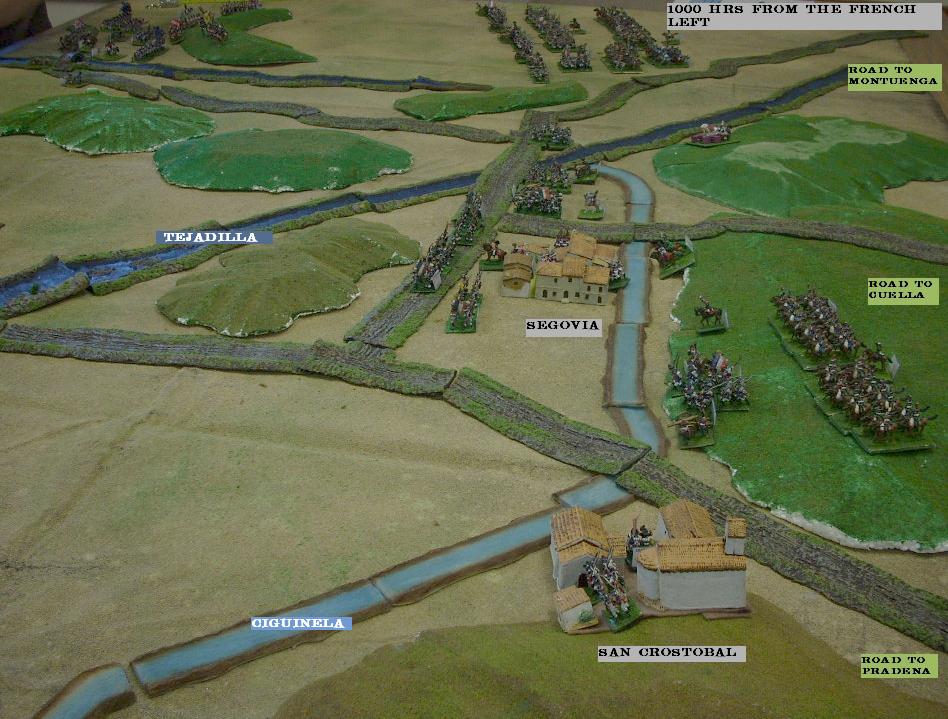
The British and Spanish positions are a direct result of their arrival from two
different directions. Their plan, upon seeing the French deployments, is for the
British to hold until their reinforcements arrive and then launch a strong
attack, in conjunction with the Spanish, against the hinge point of the French
line. The Spanish were to attack wide on the right to try to open up the road to
Pradena and also stretch Kellerman wider than his limited command abilities
could master.
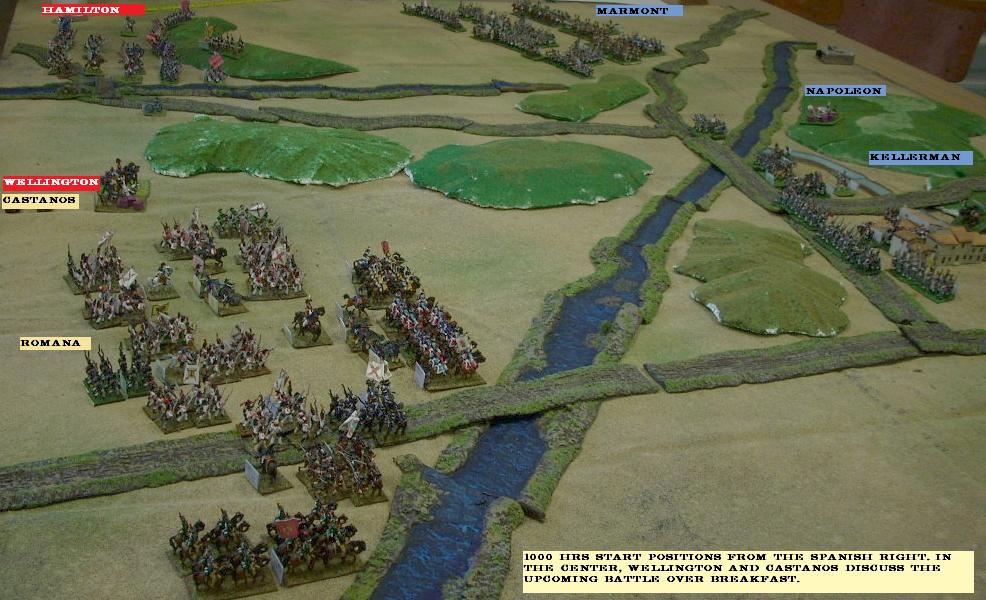
Immediately upon seeing the Spanish deployment, Kellerman commences to shift his
weight toward the right. He seems to expect the main Spanish attack to come on
the west bank of the Tejadilla. This encourages Castanos to hurry his attack and
to make it more to his right.
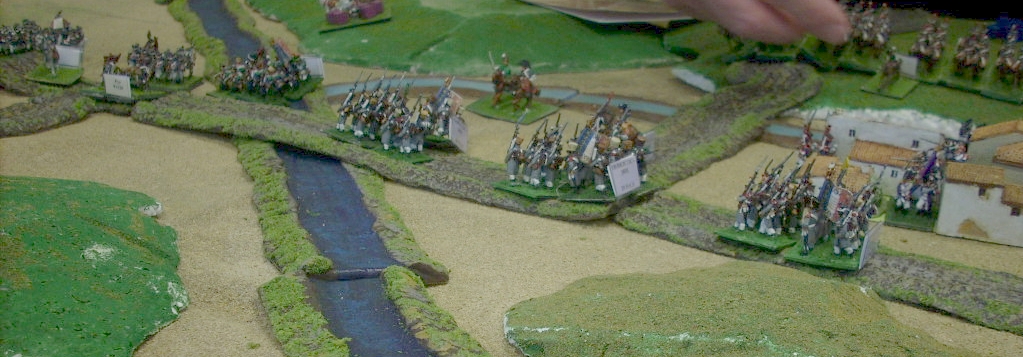
Initially, only a single Spanish division was ordered to cross the Tejadilla but
the massing of Kellerman brought the Spanish left to a halt in the center. They
would hold there under steady French artillery fire for several hours until the
British attack forces came up. In the upper left corner, the first British
reinforcements have begun to arrive in the form of Cotton's cavalry division.

An hour later and more Spanish have begun to switch banks of the stream,
unmolested by the defensive Kellerman.

For the time being, there is only a single French infantry division deployed
against the mass of the army of Spain. Spanish infantry begins to mass against
Segovia and engage it in heated firefights.
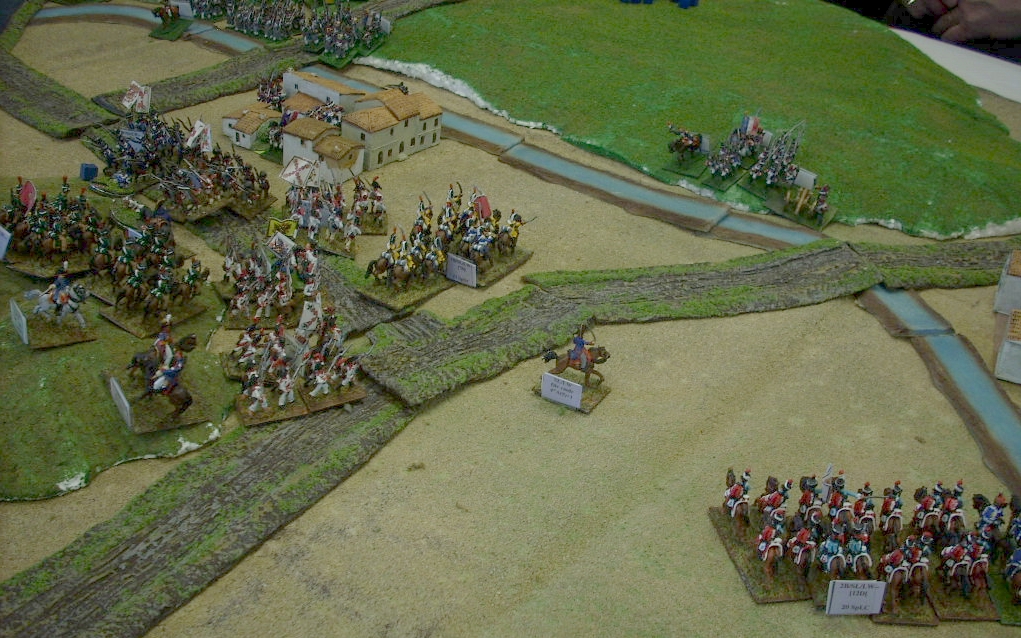
Spanish reinforcements arrive from Madrid and Guadarrama.
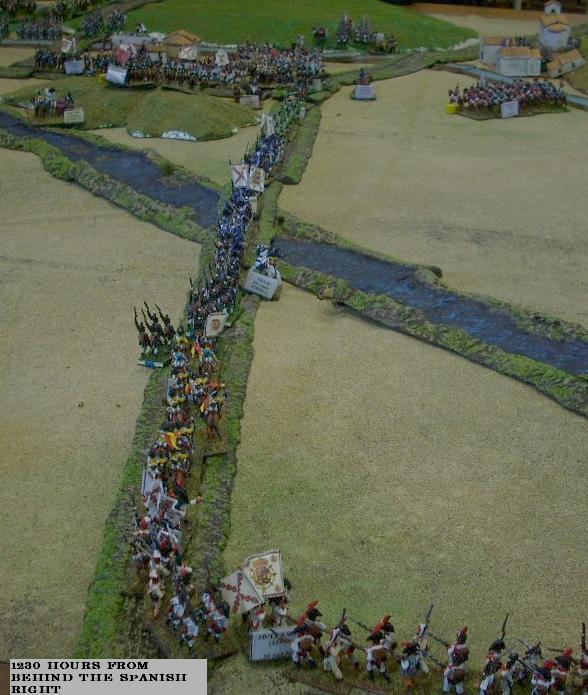
British reinforcements have also arrived in the form of Picton and Hill from
Avila. The British artillery had started to lose the duel on the left with their
French counterparts and so had been pulled back behind the crest line. This
allows Marmont's artillery to turn their fire against Picton's columns.
Hamilton's Corps holds on the left of the stream while the independent divisions
move to start the attack. Since Cotton's cavalry was a part of Hamilton's corps,
it would later be unable to effectively shift to support the attack.
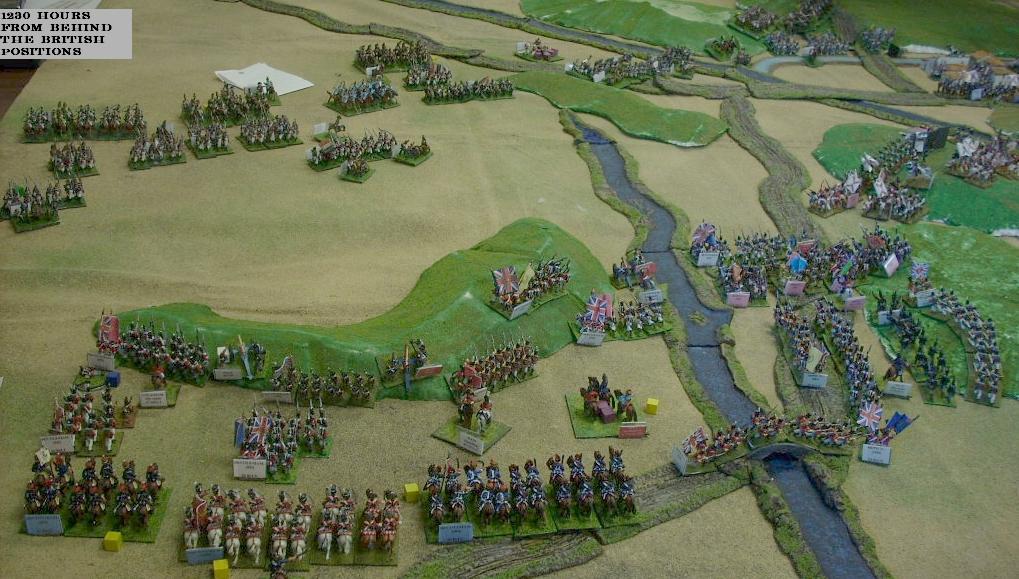
The firefight continues against Segovia while the first attacks across the
Ciguinela get good successes. The French appear surprised at the ferocity of the
Spanish that they have such disdain for.

An entire Spanish division gains a foothold across the stream. Castanos orders
the Tremp Borderers to strengthen his center and join in the combat.

Sometime around 1400 hours, Picton's columns get their attacks underway. They
would be harassed by French Hussars that would limit their effectiveness. The
massed French artillery would cause them terrible casualties. Here, on Castanos'
extreme left, Spanish divisions are flung forward to tie up French fire and try
to screen the British columns.
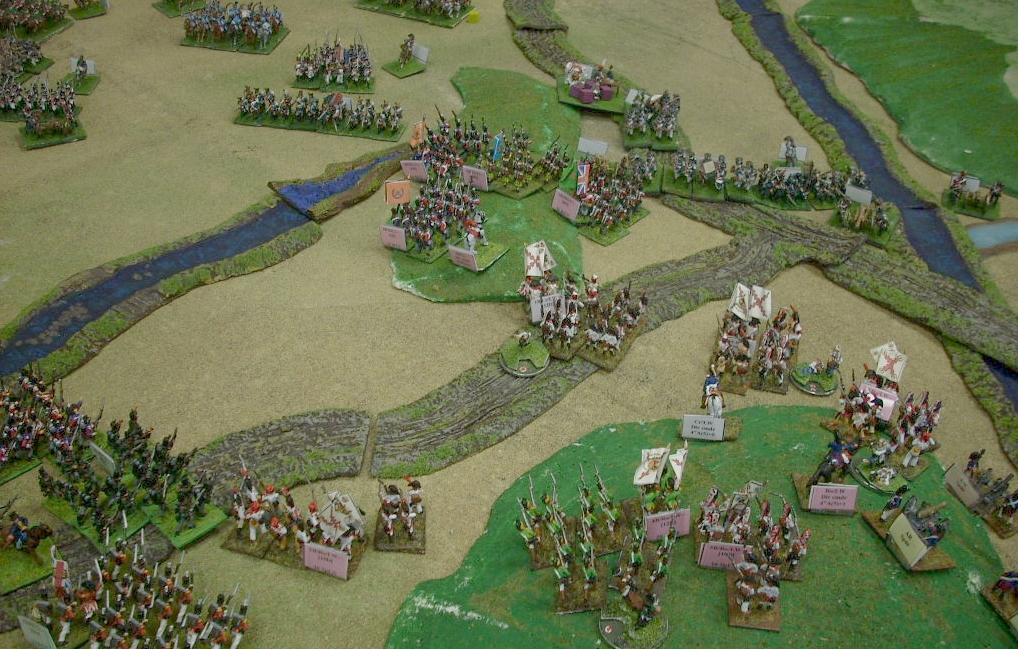
The first Spanish division that had gained the far bank of the Ciguinela stream
are entirely routed by French cavalry. The Spanish horse cannot get across the
stream to effectively support their infantry. Still, there is another Spanish
division ready to make the crossing. They will prepare the way with heavy
musketry against the Chasseurs a Cheval.

1500 hrs: From the far left to the right, British and Spanish brigades are
attacking.
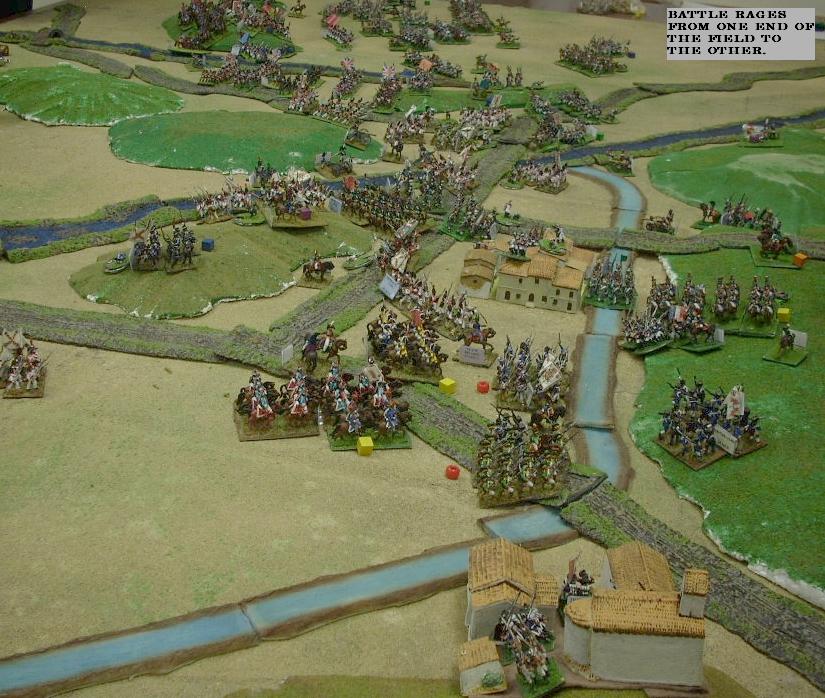
Hamilton's attack stalls in the face of French fire. The cavalry of both armies
is paralyzed by the parity and array of artillery. It is a terrible place to be
an infantryman.
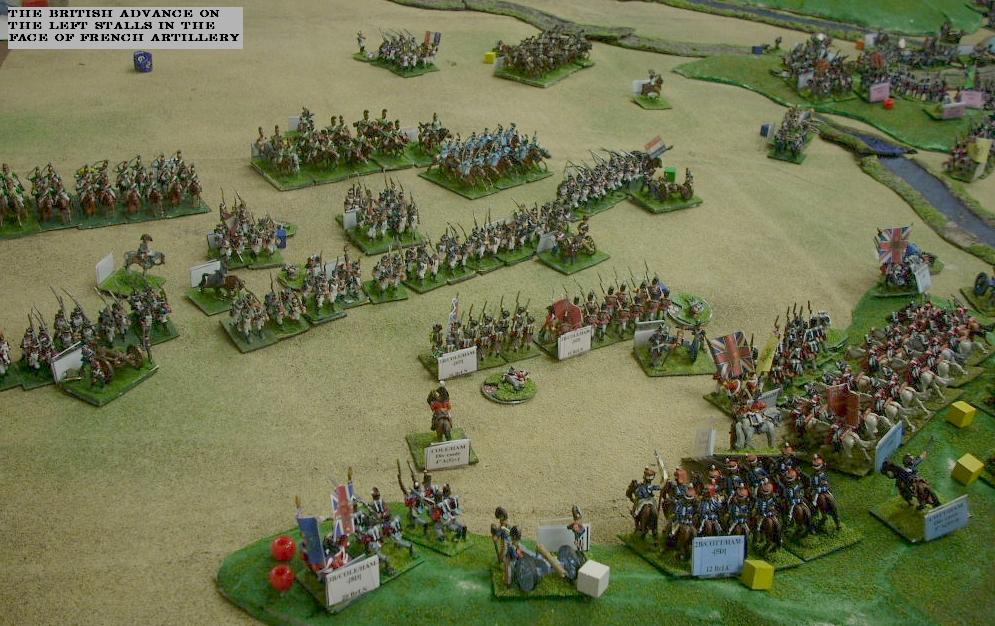
After more than three hours, Spanish troops finally are able to organize a three
pronged assault against Segovia that clears it of French defenders. They are
also once again across the Ciguinela. Kellerman's Corps is falling back and
having trouble rallying troops to continue the battle.
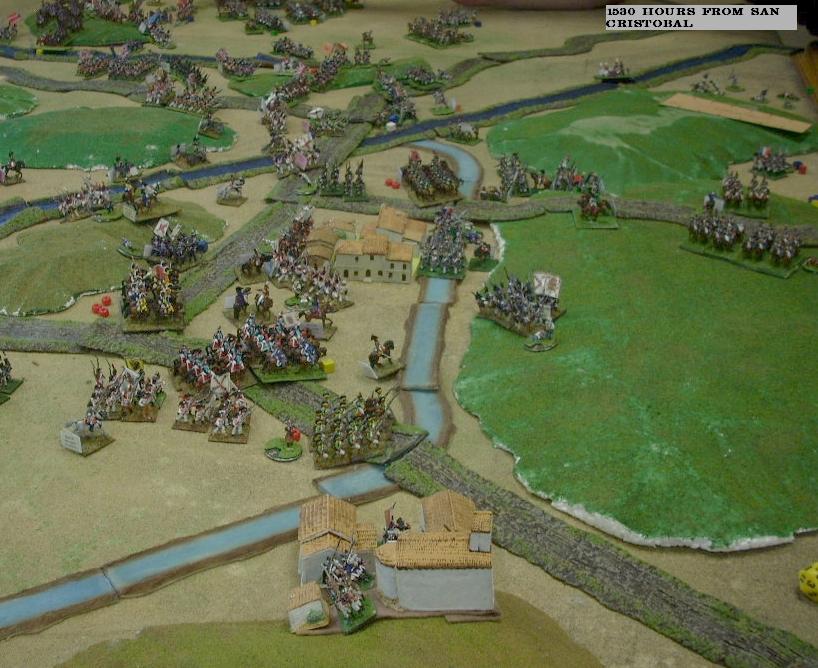
1700 hrs. Victory on the right seems assured for Castanos but his army is
becoming exhausted. Still, he presses on and brings mass fire and bayonets
against every French brigade that is to their front.
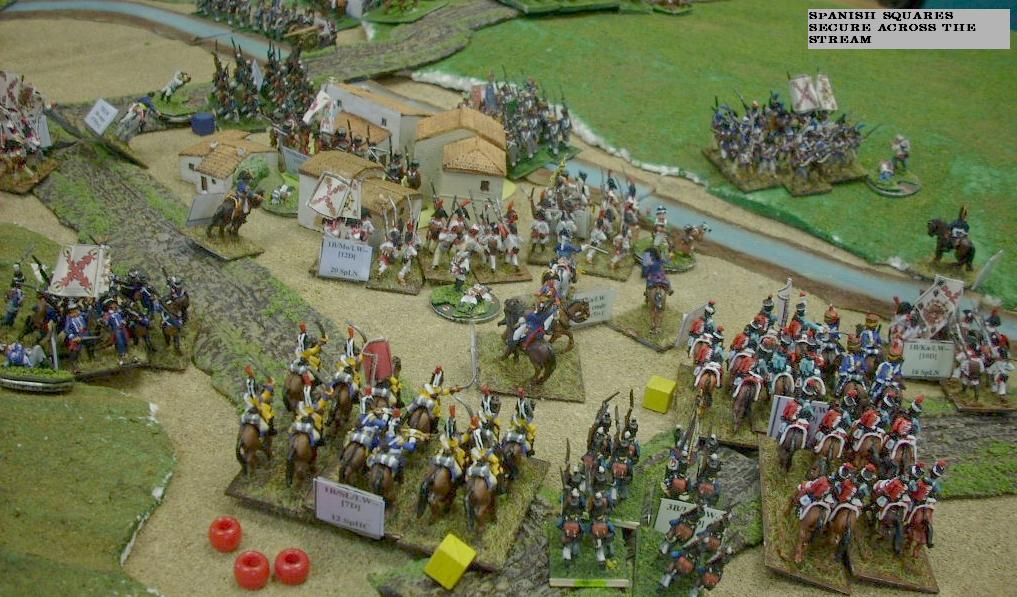
1700 hrs in the center. Hill's columns continue to press forward despite their
casualties but somehow Kellerman's infantry and artillery continue to fire their
heated guns.

1730 hours and dusk brings the fighting to a close. The remnants of Hamilton
hold their positions on the far left. Marmont has hurt them and remained strong.
It was a case of steady, well supported French lines throwing back British
columns with the deadliness of their firepower. Picton and Hill, though
battered, have secured the crossroads.
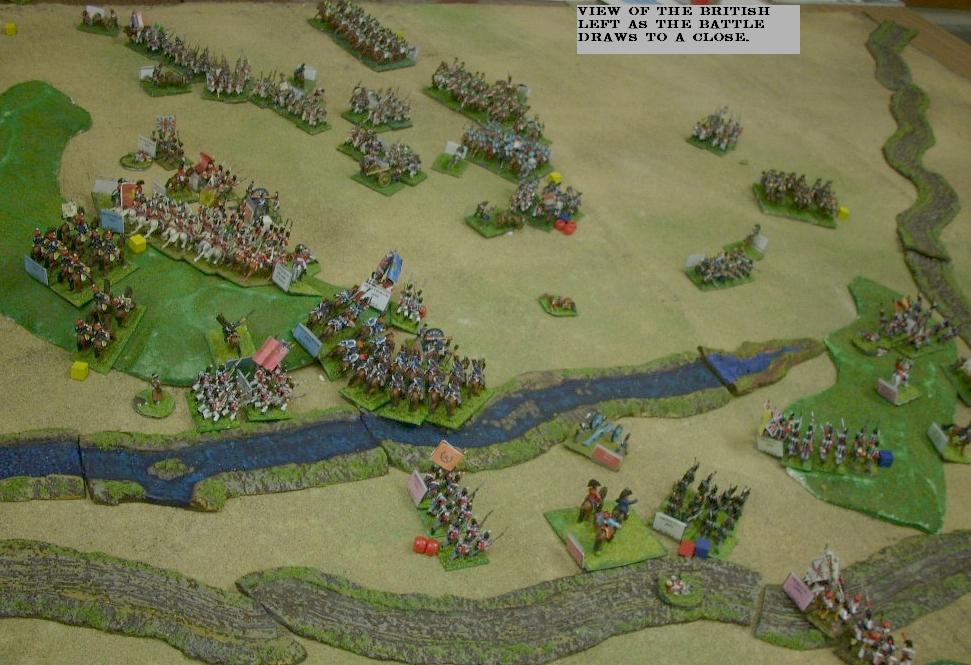
On the Spanish right, Castanos has opened the road to Pradena and taken Segovia.
Though he had briefly cut the road to Cuella, his advanced forces are driven
back by a final charge by the French Chasseurs a cheval. The cost to Castanos
though is massive and such Spanish youth has been slain this day that they might
never be replaced.

As the armies move apart to collapse exhausted onto the scrublands, Wellington
and Castanos confer. They determine that, though they surely could not stand
another day of battle if the French are reinforced, they could get perhaps two
more British divisions force marched from Salamanca and, importantly, more
artillery. Castanos, though the spine of his army is near to shattered, dares to
stand with the British.
When the word comes in the night that Napoleon has retreated his army to Cuella,
the old general falls to his knees and offers a prayer of thanks.
|
French Army for the Battle of
Segovia - July 24th
1809
(3)Armee de Pyrenees Emperor Napoleon 22"E(10)+3D (15M)
WING ARTILLERY: Fr12# Fr12# Fr12#
I Corps
(2) Corps(1C) Marmont 9"G(7)+1 (F7)
(1)Axelle (1CAx/1C) Div cmdr 4"G(5)+1 (weakened regular) (5280
infantry, 1280 cavalry)
1B/1CAx/1C: 20 FrLN [8D] 2B/1CAx/1C: 24 FrLT [10D]
3B/1CAx/1C: 16 FrLC [6D]
(1)Cosette (/1C) Div cmdr 4"E(5)+3 (weakened regular) (8640
infantry)
1B//1C: 16 FrLN [6D] 2B//1C: 16 FrLN [6D] 3B//1C:
20 FrLN [8D] 4B//1C: 20 FrLN [8D]
(1)Christiane (1CCD/1C) Div cmdr 4"A(4)+1 (Fresh regular) (4800
infantry)
1B/1CCD/1C: 20 FrLN [8D] 2B/1CCD/1C: 20 FrLN [8D]
(1)Chloe Hussars (1CCC/1C) Div cmdr 4"G(5)+2 (Fresh regular)
(3840 cavalry)
1B/1CCC/1C: 20 FrLC [8D] 2B/1CCC/1C: 16 FrLC [6D]
3B/1CCC/1C: 12 FrLC [5D]
CORPS ARTILLERY: Fr6# Fr12# Fr12#
III Corps
(2)III Corps(3C) Kellerman 6"E(7)+1 (F7)(supply train)
(1)Angevin (An3C/3C) Div cmdr 4"P(6)+2 (worn regular) (6240
infantry)
1B/An3C/3C: 16 FrLN [6D] 2B/An3C/3C: 20 FrLN [8D]
3B/An3C/3C: 16 FrLT [6D]
(1)Bevis (BE3C/3C) Div cmdr 4"A(5)+0 (worn regular) (6240
infantry)
1B/BE3C/3C: 20 FrLN [8D] 2B/BE3C/3C: 16 FrLN [6D]
3B/BE3C/3C: 16 FrLN [6D]
(1)Suze (SI3C/3C) Div cmdr 4"A(5)+2 (battered regular) (5760
infantry)
1B/SI3C/3C: 16 FrLN [6D] 2B/SI3C/3C: 16 FrLN [6D]
3B/SI3C/3C: 16 FrLN [6D]
(1)Claire Hussars (CH3C/3C) Div cmdr 4"A(5)+0 (battered regular)
(2560 cavalry)
1B/CH3C/3C: 16 FrLC [6D] 2B/CH3C/3C: 16 FrLC [6D]
CORPS ARTILLERY: Fr12# Fr6#
|
(3)Anglo-Portuguese
Expeditionary Force Wellington 17"G(8)+3D (21M)
WING ARTILLERY: Br12# Br12# Br6#
Anglo-Portuguese Expeditionary Force
(1)Picton (PICT/APEF) Div cmdr 4"P(5)+1 (Fresh regular) (12960
infantry) *Reinf turn 5 fm Avila*
1B/PICT/APEF: 20 BrLN [8D] 2B/PICT/APEF: 20 BrLN
[8D] 3B/PICT/APEF: 20 BrLT [8D] 4B/PICT/APEF: 24 BrLN
[10D]
5B/PICT/APEF: 24 BrLT [10D]
(1)Hill (HILL/APEF) Div cmdr 3"P(5)+1 (worn regular) fatigued
(7680 infantry) *Reinf turn 5Avila*
1B/HILL/APEF: 16 BrLN [6D] 2B/HILL/APEF: 16 BrLN
[6D] 3B/HILL/APEF: 16 BrLN [6D] 4B/HILL/APEF: 16 BrLN [6D]
Hamilton
(2)Hamilton(HAM) Hamilton 8"G(7)+1 (F3 until reinforced and then F6)
(supply train)
(1)Leith (LETH/HAM) Div cmdr 3"A(4)+0 (weakened regular) (5760
infantry)
1B/LETH/HAM: 16 BrLN [6D] 2B/LETH/HAM: 16 BrLN
[6D] 3B/LETH/HAM: 16 BrLN [6D]
(1)Cole (COLE/HAM) Div cmdr 4"A(5)+1 (weakened regular) (10560
infantry)
1B/COLE/HAM: 16 BrLN [6D] 2B/COLE/HAM: 16 BrLN
[6D] 3B/COLE/HAM: 20 BrLN [8D] 4B/COLE/HAM: 16 BrLT [6D]
5B/COLE/HAM: 20 BrLN [8D]
(1)Cotton (COTT/HAM) Div cmdr 3"A(5)+0 (Fresh regular) (4160
cavalry) *Reinf turn 2 fm Avila*
1B/COTT/HAM: 20 BrHC [6D] 2B/COTT/HAM: 12 BrLC
[5D] 3B/COTT/HAM: 20 BrLC [8D]
CORPS ARTILLERY: Br12# Br6#
|
|
(3)Army Real Castanos
12"E(8)+1D (21M)
WING
ARTILLERY:
Sp4# Sp12#
(1)Nadaro (Nad/AR) Div cmdr 4"A(5)-1 (F2) (Fresh regular) fatigued (8640
infantry) *Reinf ph 2 fm Madrid*
1B/Nad/AR: 24 SpLN [14D] 2B/Nad/AR: 24 SpLN [14D] 3B/Nad/AR: 24 SpLT
[14D]
Left Wing
(2)Left Wing(LW) Romana 8"G(8)+0 (F10)
(1)Tremp Borderers
(TB/LW) Div cmdr 4"P(5)+2 (worn conscript) fatigued (7200 infantry, 960
cavalry) *Reinf ph 2 fm Guadarrama*
1B/TB/LW: 20 SpLN [12D]
2B/TB/LW: 20 SpLN [12D] 3B/TB/LW: 20 SpLT [12D] 4B/TB/LW: 12 SpMC [8D]
(1)Modrena (Mo/LW) Div
cmdr 3"A(5)+1 (worn conscript) (7200 infantry, 1280 cavalry)
1B/Mo/LW: 20 SpLN [12D]
2B/Mo/LW: 20 SpLN [12D] 3B/Mo/LW: 20 SpLN [12D] 4B/Mo/LW: 16 SpMC [11D]
(1)Kaka (Ka/LW) Div cmdr
4"A(5)+1 (worn regular) (7680 infantry)
1B/Ka/LW: 16 SpLN [10D]
2B/Ka/LW: 16 SpLN [10D] 3B/Ka/LW: 16 SpLT [10D] 4B/Ka/LW: 16 SpLN [10D]
(1)Romaldo (Ro/LW)
Div cmdr 4"A(5)+1 (battered regular) (8160 infantry)
1B/Ro/LW: 16 SpLN [10D]
2B/Ro/LW: 16 SpLN [10D] 3B/Ro/LW: 16 SpLN [10D] 4B/Ro/LW: 20 SpLT [12D]
(1)Crespo (Cr/LW)
Div cmdr 4"A(5)+0 (battered regular) (4320 infantry)
1B/Cr/LW: 20 SpLN
[12D] 2B/Cr/LW: 16 SpLN [10D]
(1)Segovian Lancers
(SL/LW) Div cmdr 4"A(5)+1 (Fresh regular) (2560 cavalry)
1B/SL/LW: 12 SpHC
[7D] 2B/SL/LW: 20 SpLC [12D]
CORPS ARTILLERY: Sp4# Sp12#
|
The game is 16 turns in length. The
French get 6 re-rolls and each Allied commander gets 3 rerolls. Neither side has
the initiative.
Terrain notes: Streams all count as
rough terrain for fording. Artillery can only cross the streams at bridges.
Segovia is +1. San Cristobal is +2.
|
TAG |
UNIT TYPE |
|
COL or LIM
|
LIN or ULM
|
SQ vs CV |
vs OT |
|
DRD
/
Rtr |
RSP
/
SP |
Fire
/
MODS |
|
COL or LIM
|
LIN or ULM
|
MCH COL |
|
|
RGH or SQR
|
BCK or SID
|
CG FMN |
|
|
SpHC |
Spanish Heavy Cavalry
|
|
2/3 |
4/D |
- |
|
|
|
BrHC |
British Heavy Cavalry
|
|
2/4 |
6/B |
- |
|
|
|
SpLC |
Spanish Light Cavalry (92-08) h |
|
1/3 |
4/D |
- |
|
|
|
BrLC |
British Light Cavalry
|
|
2/3 |
6/B |
- |
|
|
|
SpMC |
Spanish Militia Cavalry h
|
|
1/2 |
3/E |
- |
|
|
|
SpLN |
Spanish Line Infantry (07-08)
|
|
1/3 |
4/D |
3"/-1 |
|
|
|
SpLT |
Spanish Light Infantry
(07-08) |
|
1/3 |
4/D |
4"/0 |
|
|
|
BrLN |
British Line Infantry (05-15)
|
|
2/5 |
6/B |
4"/+1 |
|
|
|
BrLT |
British Light/Rifle Infantry
(05-15) s |
|
2/5 |
6/B |
5"/+2 |
|
|
|
Br12# |
British Heavy Artillery
|
|
k |
6/- |
12"/+2 |
|
|
|
Sp12# |
Spanish Heavy Artillery n p
|
|
k |
4/- |
12"/-1 |
|
|
|
Sp4# |
Spanish Horse Artillery n p
|
|
k |
4/- |
8"/-1 |
|
|
|
Br6# |
British Horse Artillery
(92-09) p |
|
k |
6/- |
9"/+1 |
|
|
|
|
TAG |
UNIT TYPE |
|
COL or LIM
|
LIN or ULM
|
SQ vs CV |
vs OT |
|
DRD
/
Rtr |
RSP
/
SP |
Fire
/
MODS |
|
COL or LIM
|
LIN or ULM
|
MCH COL |
|
|
RGH or SQR
|
BCK or SID
|
CG FMN |
|
|
|
|
|
|
|
|
FrLC |
French Light Cavalry (05-12)
h |
|
2/3 |
6/C |
- |
|
|
|
FrLN |
French Line Infantry (08-12)
|
|
2/4 |
6/C |
4"/0 |
|
|
|
FrLT |
French Light Infantry (08-12)
|
|
2/4 |
6/C |
5"/+1 |
|
|
|
Fr12# |
French Heavy Artillery
|
|
k |
6/- |
12"/+2 |
|
|
|
Fr6# |
French Horse Artillery
|
|
k |
6/- |
9"/+2 |
|
|
|























